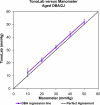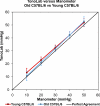Calibration of the TonoLab tonometer in mice with spontaneous or experimental glaucoma
- PMID: 20720229
- PMCID: PMC3053110
- DOI: 10.1167/iovs.10-5556
Calibration of the TonoLab tonometer in mice with spontaneous or experimental glaucoma
Abstract
Purpose: To measure the accuracy of TonoLab (TioLat, Helsinki, Finland) tonometry in mice with spontaneous or induced experimental glaucoma.
Methods: Chronic intraocular pressure (IOP) elevation was induced in one eye of 32 mice by injection of polystyrene beads and viscoelastic material. Three to 6 weeks later, the eyes were cannulated and manometrically set to 10, 20, 30, 40, or 50 mm Hg. The mice were 8-week and 8-month-old C57BL/6, 8-week-old DBA/2J, and 8-week-old CD1. The TonoLab calibration was also tested on five aged DBA/2J mice with spontaneous glaucoma. The relation of the TonoLab reading to manometric IOP was evaluated in multivariate linear regression models with axial length, IOP history, and mouse strain as independent variables.
Results: The slope of the relationship between TonoLab and manometric IOP in all the mice was 0.998, with an intercept of 2.3 mm Hg (adjusted R in univariate regression = 0.86). Neither the mice with bead-induced glaucoma nor those with spontaneous glaucoma (older DBA/2J mice) differed significantly from the control animals in having an excellent correlation between TonoLab and manometer IOP. Longer and wider mouse eyes had slightly higher tonometrically measured IOP, whether glaucomatous or control (multivariate regression, adjusted R(2) = 0.90, P < 0.0001). There was no difference in tonometric accuracy among the three mouse strains: CD1, C57BL/6, and DBA/2J, nor between 8-week and 8-month-old C57BL/6 mice (multivariate regression, P = 0.32).
Conclusions: The TonoLab accurately reflects IOP in both normal mice and in eyes of mice with experimental or spontaneous glaucoma, with no detectable effect of age.
Figures






Similar articles
-
Manometric calibration and comparison of TonoLab and TonoPen tonometers in rats with experimental glaucoma and in normal mice.J Glaucoma. 2006 Dec;15(6):512-9. doi: 10.1097/01.ijg.0000212276.57853.19. J Glaucoma. 2006. PMID: 17106364
-
Effect of Antiglaucoma Medicine on Intraocular Pressure in DBA/2J Mice.Ophthalmic Res. 2016;55(4):205-11. doi: 10.1159/000444057. Epub 2016 Mar 5. Ophthalmic Res. 2016. PMID: 26942413
-
Studies of scleral biomechanical behavior related to susceptibility for retinal ganglion cell loss in experimental mouse glaucoma.Invest Ophthalmol Vis Sci. 2013 Mar 11;54(3):1767-80. doi: 10.1167/iovs.12-10952. Invest Ophthalmol Vis Sci. 2013. PMID: 23404116 Free PMC article.
-
Noninvasive measurement of rodent intraocular pressure with a rebound tonometer.Invest Ophthalmol Vis Sci. 2005 Dec;46(12):4617-21. doi: 10.1167/iovs.05-0781. Invest Ophthalmol Vis Sci. 2005. PMID: 16303957
-
Agreement of tonometer for measuring intraocular pressure in Wistar rats: a systematic review.Eur J Med Res. 2024 Jun 16;29(1):332. doi: 10.1186/s40001-024-01927-z. Eur J Med Res. 2024. PMID: 38880889 Free PMC article.
Cited by
-
Changes of Ocular Dimensions as a Marker of Disease Progression in a Murine Model of Pigmentary Glaucoma.Front Pharmacol. 2020 Sep 4;11:573238. doi: 10.3389/fphar.2020.573238. eCollection 2020. Front Pharmacol. 2020. PMID: 33013417 Free PMC article.
-
Safety, efficacy and delivery of multiple nucleoside analogs via drug encapsulated carbon (DECON) based sustained drug release platform.Eur J Pharm Biopharm. 2022 Apr;173:150-159. doi: 10.1016/j.ejpb.2022.03.001. Epub 2022 Mar 21. Eur J Pharm Biopharm. 2022. PMID: 35314347 Free PMC article.
-
Experimental scleral cross-linking increases glaucoma damage in a mouse model.Exp Eye Res. 2014 Nov;128:129-40. doi: 10.1016/j.exer.2014.08.016. Epub 2014 Oct 5. Exp Eye Res. 2014. PMID: 25285424 Free PMC article.
-
Comparison of iCare tonometer and Goldmann applanation tonometry in normal corneas and in eyes with automated lamellar and penetrating keratoplasty.Eye (Lond). 2011 May;25(5):642-50. doi: 10.1038/eye.2011.60. Epub 2011 Mar 25. Eye (Lond). 2011. PMID: 21436848 Free PMC article.
-
Prolonged elevation of intraocular pressure results in retinal ganglion cell loss and abnormal retinal function in mice.Exp Eye Res. 2015 Jan;130:29-37. doi: 10.1016/j.exer.2014.11.007. Epub 2014 Nov 18. Exp Eye Res. 2015. PMID: 25450059 Free PMC article.
References
-
- John SW, Hagaman JR, MacTaggart TE, Peng L, Smithes O. Intraocular pressure in inbred mouse strains. Invest Ophthalmol Vis Sci. 1997;38:249–253 - PubMed
-
- Avila MY, Carre DA, Stone RA, Civan MM. Reliable measurement of mouse intraocular pressure by a servo-null micropipette system. Invest Ophthalmol Vis Sci. 2001;42:1841–1846 - PubMed
-
- Cohan BE, Bohr DF. Measurement of intraocular pressure in awake mice. Invest Ophthalmol Vis Sci. 2001;42:2560–2562 - PubMed
-
- Danias J, Kontiola AI, Filippopoulos T, Mittag T. Method for the noninvasive measurement of intraocular pressure in mice. Invest Ophthalmol Vis Sci. 2003;44:1138–1141 - PubMed
-
- Grozdanic SD, Betts DM, Sakaguchi DS, et al. Laser-induced mouse model of chronic ocular hypertension. Invest Ophthalmol Vis Sci. 2003;44:4337–4346 - PubMed
Publication types
MeSH terms
Grants and funding
LinkOut - more resources
Full Text Sources
Medical

